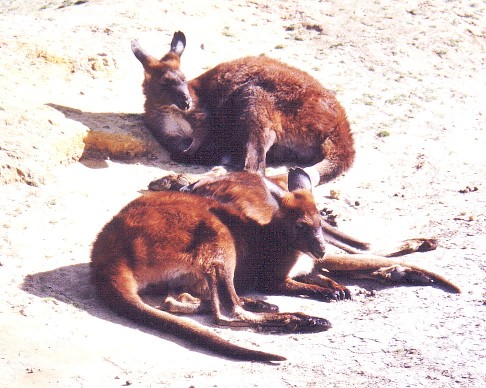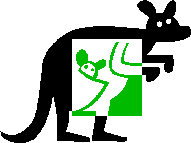HABITAT & INTERACTIONS
 The
Red Kangaroo is somewhat special among others because of its ability to survive
in desert and semi-desert regions. Its distribution includes central
Australia, the rangelands of western New South Wales, and the arid portions of
the country. However, it can usually be found in any area which provides
shelter and water. Other species of kangaroo are found more densely in
costal regions because of their greater dependency on water and vegetation. One
interesting fact about the Red Kangaroo is that its location may determine the
color of its coat, and throughout Australia, the usual "male is red and female
is blue" may be reversed.
The
Red Kangaroo is somewhat special among others because of its ability to survive
in desert and semi-desert regions. Its distribution includes central
Australia, the rangelands of western New South Wales, and the arid portions of
the country. However, it can usually be found in any area which provides
shelter and water. Other species of kangaroo are found more densely in
costal regions because of their greater dependency on water and vegetation. One
interesting fact about the Red Kangaroo is that its location may determine the
color of its coat, and throughout Australia, the usual "male is red and female
is blue" may be reversed.
The Red Kangaroo is considered to be a sedentary yet territorial animal. Each individual usually establishes some type of home range, usually measuring 2.7 square miles for females and 3.9 square miles for males. Once an individual has established a home range, it most often lives there for several years in various resting sites. Home ranges established by the Red Kangaroo are usually not set up extremely close to water or vegetation, therefore the kangaroo must sometimes travel far distances to attain adequate nutrition, especially during times of drought. The home range for a typical Red Kangaroo includes a few trees to provide shade, land for grazing, and a water source that is within ten miles of the home range. Although it may seem that the Red Kangaroo has not chosen the best habitat for its survival, one key reason for living in desolate areas is to provide protection from predation. Naturally, the Red Kangaroo has few predators. The most common is the Dingo, a dog-like animal that has rusty-orange fur. Joeys may fall prey to eagles and foxes, but the only other predator to adult Red Kangaroos are humans. Although this species has chosen to live in some desolate areas, it is still necessary for the Kangaroo to know its home range quite well so that it can anticipate hiding predators and establish escape routes.
Since the Red Kangaroo lives in such desolate areas, its interactions with other species is somewhat limited. Some areas the kangaroo inhabits are large farm fields where sheep graze. In these regions kangaroos compete with sheep for grazing land and the dense and nutritious vegetation. Red Kangaroos also live here because of "dingo" fences that farmers put up to protect their flocks from being attacked. When kangaroos live here, they also enjoy this protection. Farmers, however, do not usually enjoy kangaroos eating the vegetation meant for their flock, and kangaroos are sometimes shot because they are seen as pests. Red Kangaroos also have internal interaction with a variety of specialized microorganisms including bacteria, fungi, and protozoans. These microorganisms live in the fermentation vat of the kangaroos gut and help to break down cellulose, lignin, and other carbohydrates that the kangaroo would not be able to digest with its own natural digestive enzymes. It seems as though this is a mutualistic relationship in which both the Kangaroo and the microorganisms benefit.
Kangaroos also serve multiple purposes for humans. Before Europeans entered Australia, Aborigines relied on kangaroos for food. The kangaroo also played a large part in their culture. Today kangaroos are still utilized for their meat and skins which are used for clothing and food. Since kangaroos have only a few predators that are close or at the top of the food chain, they are also considered to be fairly high. They are herbivorous, foraging animals and do not depend on catching active prey for their nutrition.

